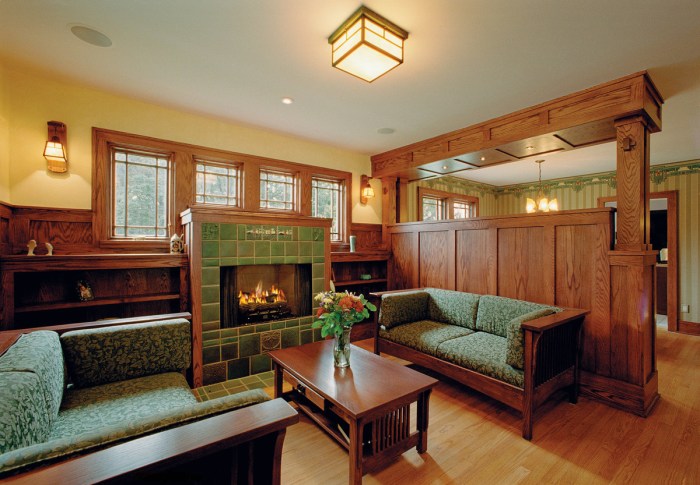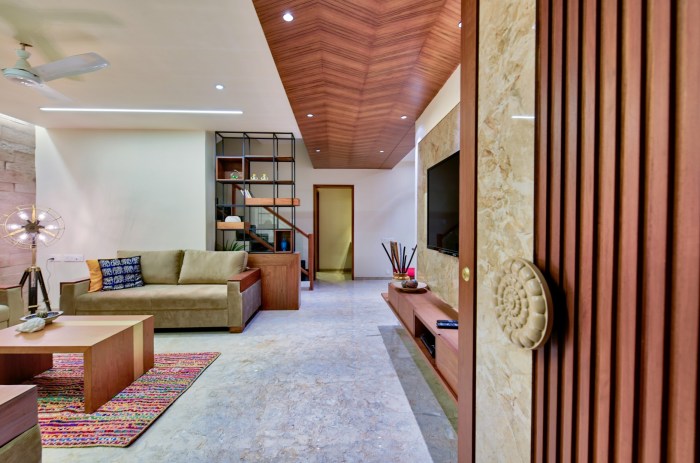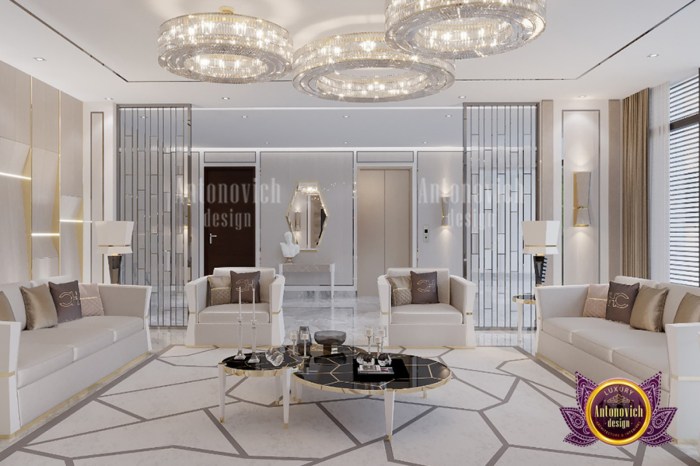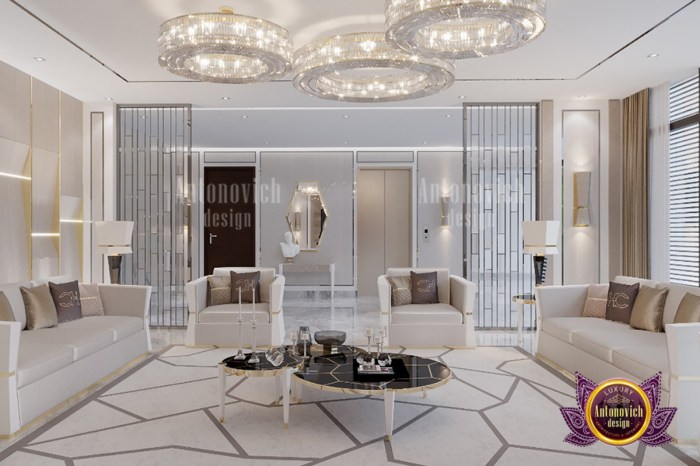Bungalow house interior design embodies a timeless charm, blending practicality with aesthetic appeal. This style, originating in the early 20th century, has evolved into a versatile and enduring design choice, capturing the essence of cozy living spaces. From its humble beginnings as a modest dwelling, the bungalow has become a symbol of warmth and inviting comfort, offering a unique blend of traditional and modern elements.
Bungalow houses are known for their low-pitched roofs, wide porches, and open floor plans. These features create a sense of spaciousness and connection with the outdoors, a hallmark of the bungalow style. The interior design emphasizes natural materials, earthy color palettes, and a focus on functionality.
This guide explores the key elements of bungalow house interior design, offering insights into layout, color choices, furniture selection, and decorative accents.
Furniture Selection

Choosing the right furniture is crucial for achieving a cohesive and authentic bungalow aesthetic. The furniture you select should not only be comfortable and functional but also complement the bungalow’s architectural style and evoke a sense of warmth and charm.
Furniture Styles
Furniture styles that align well with the bungalow aesthetic include:
- Mission Revival:This style, characterized by its clean lines, simple forms, and use of natural materials, complements the bungalow’s emphasis on functionality and craftsmanship. Mission Revival furniture often features exposed wood frames, sturdy construction, and minimalist ornamentation.
- Arts and Crafts:Inspired by the Arts and Crafts movement, this style emphasizes handcrafted furniture with a focus on natural materials and traditional craftsmanship. Arts and Crafts furniture often features intricate details, hand-carved elements, and a rustic charm.
- Mid-Century Modern:While not strictly a bungalow style, Mid-Century Modern furniture can complement the bungalow’s emphasis on simplicity and functionality. Mid-Century Modern pieces often feature clean lines, organic shapes, and a focus on comfort and practicality.
Furniture Materials
The materials used for bungalow furniture should blend seamlessly with the interior design.
- Wood:Natural wood, such as oak, maple, and cherry, is a classic choice for bungalow furniture. These woods add warmth, character, and a sense of authenticity to the space.
- Leather:Leather upholstery adds a touch of luxury and sophistication to bungalow interiors. Leather sofas, chairs, and ottomans create a cozy and inviting atmosphere.
- Wicker and Rattan:These natural materials are perfect for creating a light and airy feel in a bungalow. Wicker and rattan furniture can be used for seating, storage, and accent pieces.
Vintage and Antique Furniture
Incorporating vintage and antique furniture pieces can enhance the bungalow’s charm and character.
- Antique Sofas and Chairs:A vintage sofa or armchair with elegant lines and intricate details can be a focal point in a bungalow living room. Look for pieces with tufted upholstery, claw feet, or ornate carvings.
- Vintage Sideboards and Cabinets:These pieces can provide storage and display space while adding a touch of history to the bungalow. Look for sideboards with intricate hardware, carved details, or a distressed finish.
- Antique Mirrors:Antique mirrors can add a touch of elegance and visual interest to a bungalow. Look for mirrors with ornate frames, etched designs, or a distressed finish.
Kitchen Design
The kitchen is the heart of any home, and in a bungalow, it’s no different. A well-designed bungalow kitchen balances functionality and charm, creating a space that’s both practical and inviting.
Bungalow house interior design often emphasizes a cozy and inviting atmosphere. This can be achieved through the use of warm colors, natural materials, and comfortable furniture. However, even with a smaller footprint, you can still create a beautiful and functional space.
For inspiration on how to maximize space in a compact dwelling, check out this article on 25 sqm house interior design. The principles of maximizing space and creating a welcoming atmosphere apply to both bungalow homes and smaller spaces, so you can find plenty of ideas that translate well across different sizes and styles.
Layout and Design Considerations
The bungalow’s compact nature calls for a kitchen layout that maximizes space and flow. Open floor plans are common in bungalows, so the kitchen often blends seamlessly with the dining area or living room.
- Galley Kitchen:This layout is ideal for smaller bungalows, with parallel countertops and appliances along two walls. This maximizes counter space and creates a streamlined work triangle.
- L-Shaped Kitchen:An L-shaped layout offers more flexibility and provides ample counter space and storage.
- U-Shaped Kitchen:While less common in bungalows due to space limitations, a U-shaped kitchen can work in larger bungalows, offering maximum storage and counter space.
Incorporating Modern Appliances
Bungalows often have a traditional aesthetic, but that doesn’t mean you can’t incorporate modern appliances.
Bungalow house interior design often embraces a sense of warmth and coziness, utilizing natural materials and earthy tones. This approach can be further enhanced by incorporating elements inspired by the seaside, drawing from the relaxed and airy aesthetic of beach house coastal interior design.
Think light-washed wood, breezy linens, and pops of ocean-inspired blues and greens. By incorporating these coastal influences, you can create a bungalow interior that evokes a sense of tranquility and effortless charm.
- Integrated Appliances:Seamlessly blend appliances into the cabinetry for a clean, streamlined look.
- Stainless Steel Appliances:A classic choice that adds a touch of modern sophistication while still complementing traditional bungalow elements.
- Smart Appliances:Add convenience and functionality with smart appliances that can be controlled remotely.
Bungalow Kitchen Design Examples
- Rustic Chic:Combine reclaimed wood cabinets, exposed brick, and vintage light fixtures with modern stainless steel appliances for a warm, inviting feel.
- Modern Farmhouse:White cabinetry, open shelving, and a farmhouse sink create a clean, airy feel, while exposed beams and a rustic island add warmth and character.
- Mid-Century Modern:Embrace clean lines, geometric shapes, and warm wood tones with bold accents like a vintage pendant light or a colorful backsplash.
Bathroom Design

The bathroom is a crucial space in any home, and bungalow bathrooms are no exception. Bungalow bathrooms are known for their charm and functionality, reflecting the overall style of the home. They often feature simple, yet elegant designs that create a relaxing and inviting atmosphere.
Design Considerations, Bungalow house interior design
Bungalow bathrooms often embrace a minimalist aesthetic, prioritizing functionality and practicality. The design considerations for a bungalow bathroom include:
- Space Optimization:Bungalow bathrooms are often smaller than those in larger homes, so optimizing space is crucial. Consider using compact fixtures, such as pedestal sinks or corner showers, to maximize usable area.
- Natural Light:Bungalows often feature large windows, allowing for ample natural light. This is a key element in creating a bright and airy bathroom. Maximize natural light by using a light color palette and strategically placing mirrors to reflect light.
- Storage Solutions:Efficient storage is essential in a smaller bathroom. Incorporate built-in shelves, cabinets, or a vanity with ample storage space to keep toiletries and towels organized.
- Accessibility:Bungalows often cater to older homeowners or those with mobility limitations. Consider adding features like grab bars, walk-in showers, and non-slip flooring for accessibility.
Natural Materials and Color Palettes
Bungalow bathrooms often feature natural materials that enhance the overall aesthetic and create a sense of warmth and comfort. These materials include:
- Wood:Wood is a popular choice for bungalow bathroom vanities, cabinets, and flooring. The use of wood adds a rustic charm and complements the bungalow’s overall style. Consider using reclaimed wood or distressed wood for a vintage feel.
- Stone:Stone, such as marble or granite, is often used for countertops, floors, and shower walls. Stone adds a touch of elegance and sophistication to the bathroom, creating a spa-like atmosphere. Consider using natural stone tiles for a more rustic and earthy feel.
- Tile:Tile is a versatile material that can be used for various bathroom surfaces. Bungalow bathrooms often feature tile with geometric patterns or muted colors. Consider using subway tile for a classic and timeless look, or patterned tile for a more modern and eclectic feel.
Color palettes in bungalow bathrooms are often inspired by nature, creating a sense of calm and tranquility.
- Neutral Colors:Neutral colors, such as white, beige, gray, and cream, create a spacious and airy feel. They also provide a blank canvas for adding pops of color through accessories.
- Earthy Tones:Earthy tones, such as browns, greens, and blues, are inspired by nature and add a touch of warmth and depth to the bathroom. These colors can be used on the walls, flooring, or in accessories.
- Accent Colors:Accent colors can be used to add pops of personality to the bathroom. Consider using bright colors like turquoise, yellow, or coral in towels, rugs, or artwork.
Examples of Bungalow Bathroom Designs
Here are some examples of bungalow bathroom designs that showcase the use of natural materials and color palettes:
- A bathroom with a reclaimed wood vanity, white subway tile walls, and a stone countertop.This bathroom features a neutral color palette with a rustic touch, creating a warm and inviting atmosphere.
- A bathroom with a freestanding bathtub, patterned tile floors, and a large window that allows natural light to flood the space.This bathroom embraces a modern bungalow style with a touch of elegance and sophistication.
- A bathroom with a walk-in shower, a pedestal sink, and a small window that provides natural light.This bathroom is designed for accessibility and features a simple and functional design.
Outdoor Spaces
Bungalows, with their low-pitched roofs and cozy layouts, naturally lend themselves to seamless indoor-outdoor living. Outdoor spaces in a bungalow are an extension of the home, enhancing the overall living experience and creating a welcoming atmosphere for relaxation and entertainment.
Design Considerations for Outdoor Spaces
The design of a bungalow’s outdoor space should complement the architectural style of the home, creating a cohesive and harmonious aesthetic. Here are some key considerations:
- Integration with the Home’s Style:The outdoor space should seamlessly flow from the bungalow’s interior, reflecting the same design elements and materials. This can be achieved through matching colors, textures, and furniture styles. For example, a bungalow with a rustic aesthetic could incorporate natural stone, wood, and wrought iron in the outdoor space.
- Functionality:Consider how the outdoor space will be used. Do you envision it as a relaxing retreat, an entertaining area, or a space for dining? Designing with purpose ensures the space is both functional and enjoyable.
- Privacy:Create a sense of privacy in your outdoor space by using landscaping elements like hedges, trellises, or fences. These elements can also define different areas within the space, such as a dining area, a lounge area, or a play area.
- Natural Light and Ventilation:Take advantage of natural light and ventilation by incorporating open spaces and using light-colored materials. This creates a bright and airy ambiance, extending the feeling of spaciousness beyond the bungalow’s walls.
- Climate Considerations:Design your outdoor space with your climate in mind. In hot climates, consider incorporating shade structures, awnings, or pergolas. In colder climates, think about adding a fireplace or a covered area for warmth and protection from the elements.
Creating a Welcoming and Functional Outdoor Area
A well-designed outdoor space can be a true extension of your bungalow, offering a place to relax, entertain, and connect with nature. Here are some tips for creating a welcoming and functional outdoor area:
- Define Zones:Create distinct zones within your outdoor space to accommodate different activities. For example, a dining area, a seating area, and a play area can be defined using landscaping elements, furniture arrangements, or lighting.
- Comfortable Seating:Invest in comfortable seating options, such as outdoor sofas, chairs, and cushions. Consider the size of your space and the number of people you expect to entertain.
- Outdoor Lighting:Proper lighting is essential for creating ambiance and functionality. Consider using string lights, lanterns, or solar-powered lights to illuminate the space at night.
- Greenery and Plants:Incorporate plants and flowers to add color, texture, and fragrance to your outdoor space. Choose plants that are well-suited to your climate and soil conditions.
- Outdoor Kitchen or Bar:If you enjoy entertaining, consider adding an outdoor kitchen or bar. This can be as simple as a small grill or as elaborate as a fully equipped outdoor cooking area.
- Water Features:A water feature, such as a fountain or pond, can add a calming and soothing element to your outdoor space. It can also attract birds and other wildlife.
Bungalow Outdoor Design Examples
- Tropical Bungalow:Imagine a bungalow nestled in a lush tropical setting. The outdoor space features a spacious patio with wicker furniture, a hammock strung between palm trees, and a small swimming pool surrounded by tropical plants. The overall ambiance is one of relaxation and escape.
- Modern Bungalow:A modern bungalow might feature a sleek outdoor space with clean lines and minimalist furniture. A concrete patio with a fire pit, surrounded by succulents and drought-tolerant plants, creates a modern and inviting space.
- Rustic Bungalow:A rustic bungalow could have a charming outdoor space with a wooden deck, a fire pit, and a cozy seating area with Adirondack chairs. A small vegetable garden or herb garden adds to the rustic charm.
Modern Bungalow Style

The bungalow style, with its roots in the late 19th and early 20th centuries, has experienced a resurgence in popularity, particularly in its modern iteration. This contemporary adaptation retains the essence of the traditional bungalow while incorporating modern design elements, creating a unique and stylish living space.
Evolution of the Bungalow Style
The bungalow style originated in India, where it was a simple, single-story dwelling designed for a warm climate. The style was introduced to the West in the late 19th century and quickly gained popularity in the United States and Europe.
Early bungalows were characterized by their low-pitched roofs, wide eaves, and open floor plans. They often featured porches and large windows that allowed for natural light and ventilation.
Modern Bungalow Interiors: Blending Tradition and Contemporary
Modern bungalow interiors take inspiration from the traditional style while incorporating contemporary elements. This blend creates a unique and stylish living space that is both comfortable and functional. Here are some key features of modern bungalow interiors:
- Open Floor Plans:Modern bungalows typically feature open floor plans that connect the living, dining, and kitchen areas. This creates a sense of spaciousness and flow, making the home feel larger than it actually is.
- Natural Materials:Natural materials, such as wood, stone, and bamboo, are often used in modern bungalow interiors. These materials create a warm and inviting atmosphere, and they also complement the bungalow’s rustic aesthetic.
- Neutral Color Palettes:Modern bungalow interiors often feature neutral color palettes, such as white, gray, and beige. These colors create a clean and sophisticated look, and they also provide a backdrop for pops of color from furniture, artwork, and accessories.
- Statement Lighting:Modern bungalow interiors often feature statement lighting, such as pendant lights, chandeliers, and sconces. These lighting fixtures add a touch of drama and elegance to the space.
Examples of Modern Bungalow Designs
Here are some examples of modern bungalow designs that showcase the blend of traditional and contemporary elements:
- California Bungalow:The California bungalow is a popular style that incorporates elements of the Arts and Crafts movement. It features a low-pitched roof, a wide porch, and large windows. Modern California bungalows often feature open floor plans, natural materials, and a neutral color palette.
- Mid-Century Modern Bungalow:Mid-century modern bungalows blend the traditional bungalow style with the clean lines and geometric shapes of mid-century modern design. They often feature large windows, open floor plans, and a focus on natural materials.
- Contemporary Bungalow:Contemporary bungalows are characterized by their sleek and modern lines. They often feature bold geometric shapes, minimalist furniture, and a focus on functionality.
Final Conclusion
Creating a bungalow house interior that reflects your personal style and embraces the charm of this classic design is a rewarding endeavor. By understanding the fundamental principles of bungalow design and incorporating modern elements, you can craft a living space that is both timeless and uniquely yours.
Whether you’re drawn to the rustic warmth of a Craftsman bungalow or the airy elegance of a Spanish Colonial, the bungalow style offers a rich tapestry of possibilities for creating a truly inviting and personalized home.
Question Bank: Bungalow House Interior Design
What are some common mistakes to avoid when designing a bungalow house interior?
Overcrowding the space with too much furniture, neglecting natural light, and using overly modern or trendy elements that clash with the bungalow’s traditional aesthetic are common pitfalls to avoid.
How can I incorporate modern elements into a bungalow house interior while maintaining its charm?
Choose modern furniture with clean lines and simple shapes, incorporate bold pops of color, and update lighting fixtures with contemporary designs.
What are some budget-friendly ways to update a bungalow house interior?
Repainting walls, adding a fresh coat of stain to wood floors, updating window treatments, and incorporating vintage or antique furniture pieces can transform a bungalow interior without breaking the bank.
